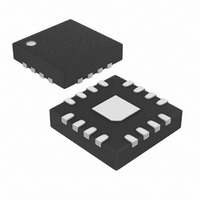MAX8568AETE+ Maxim Integrated Products, MAX8568AETE+ Datasheet - Page 9

MAX8568AETE+
Manufacturer Part Number
MAX8568AETE+
Description
IC BATT MANAGE LITH 16-TQFN
Manufacturer
Maxim Integrated Products
Datasheet
1.MAX8568AETET.pdf
(17 pages)
Specifications of MAX8568AETE+
Function
Back-Up Management
Battery Type
Lithium-Ion (Li-Ion); Nickel-Metal Hydride (NiMH)
Voltage - Supply
2.8 V ~ 5.5 V
Operating Temperature
-40°C ~ 85°C
Mounting Type
Surface Mount
Package / Case
16-TQFN Exposed Pad
Lead Free Status / RoHS Status
Lead free / RoHS Compliant
The MAX8568A/MAX8568B are compact ICs for manag-
ing backup battery charging and utilization in PDAs and
other smart handheld devices. The MAX8568A/
MAX8568B are comprised of three major blocks: 1) A
multichemistry charger for small lithium-ion, lithium-man-
ganese, LiVeO
low-current step-up DC-DC converter that generates a
boosted backup supply when the backup battery output
is less than required; and 3) an LDO that supplies a
second backup voltage to an additional system block
(typically low-voltage RAM).
The backup battery charger charges most types of
rechargeable lithium and NiMH cells. Charging current
can be set up to 25mA by a resistor connected from
CHGI to GND. The charger operates a current-limited
voltage source for rechargeable lithium batteries, and
switches between fast and trickle charging for NiMH
batteries.
The NiMH charger operates at two different charge cur-
rents based upon the voltages at TERMV and STRTV.
V
(set by CHGI) occurs. V
point where fast charging stops and trickle charging
begins, and also sets a maximum voltage limit for the
NiMH battery. If V
at 1.2 / 0.86 = 1.4V, and the maximum voltage limit is
1.2 / 0.67 = 1.791V.
An NiMH battery fast charges until it hits 1.4V set by
V
a current that is 10% of fast charge (set by CHGI). If the
voltage drops (due to loading or self-discharge) to 1.2V
(with V
age then increases back to 1.4V (with V
trickle charge resumes. If the cell voltage reaches 1.8V,
the charge current falls to zero.
When charging rechargeable lithium-type batteries,
V
Charge current is set by a resistor from CHGI to GND.
There is no trickle charge for lithium mode. This charging
scheme is essentially a current-limited voltage source.
If an NiMH battery or lower-voltage rechargeable lithium
battery is used for backup, it may be necessary to boost
the battery voltage to 2.5V, 3.3V, or some other voltage to
power RAM, RTC, or other devices. The step-up DC-DC
converter is powered by the backup battery but requires
TERMV
STRTV
TERMV
STRTV
. The charger then switches to trickle charge at
sets the BK voltage below which fast charging
sets the charging voltage while V
= 1.2V), fast charge resumes. If the volt-
5
, and NiMH batteries; 2) a small very-
TERMV
_______________________________________________________________________________________
Detailed Description
Step-Up DC-DC Converter
is 1.2V, then fast charge stops
TERMV
Multichemistry Charger
Lithium Charging Scheme
NiMH Charging Scheme
Complete Backup-Management ICs
sets the upper BK trip
STRTV
TERMV
for Lithium and NiMH Batteries
is unused.
= 1.2V),
that the I/O supply be activated at least one time before
the backup battery can be stepped up. This allows the
end product to draw no backup battery current while “on
the shelf” waiting for its first activation. The step-up DC-
DC converter is enabled, and reaches regulation, 50µs
(typ) after INOK falls below 2.43V (typ).
The step-up converter includes a built-in synchronous
rectifier that reduces cost by eliminating the need for
an external diode and improves overall efficiency. The
converter also features a clamp circuit that reduces
EMI due to inductor ringing. The output voltage is set to
3.3V or 2.5V by connecting BKV to either GND or
BKSU, respectively. For adjustable output, connect
BKV to a resistor-divider from BKSU to GND.
For designs that require two different backup voltages,
the MAX8568 includes a small LDO that is powered from
BKSU. This LDO can supply up to 10mA and uses only
5µA of operating current. The LDO output is preset to
2.5V in the MAX8568A and 1.8V in the MAX8568B. The
LDO is activated after V
See Figure 1 for switchover timing. If the backup bat-
tery is connected to the system before main power, the
MAX8568 remains off and draws very little current, typi-
cally less than 0.5µA. This allows the end product to
draw no backup battery current while “on the shelf”
waiting for its first activation. When main power is con-
nected, the MAX8568 powers on, assuming the main
battery is greater than 2.8V. The MAX8568 begins to
charge the backup battery if needed (see the
Multichemistry Charger section). The OD1 and OD2
outputs pull to GND and turn on the external p-channel
MOSFETs. This allows the voltage on I/O IN and MEM
IN (Figure 7) to pass through to the I/O OUT and MEM
OUT outputs. These I/O and MEM voltages are typically
provided by a MAX1586/MAX1587 power-supply IC.
INOK monitors the main battery voltage and activates
the backup boost converter and LDO when the voltage
on V
starts 50µs after V
impedance and turn off the external p-channel
MOSFETs. These MOSFETs disconnect the I/O IN and
MEM IN inputs from the load. This ensures that the I/O
and MEM main supplies do not draw current from the
backup source (MAX8568). The charger also turns off
when INOK is less than 2.43V.
If the MAX8568 is being evaluated as a stand-alone
device, note that the backup-battery boost converter will
not operate unless I/O IN has been activated at least one
time. The typical power removal sequence for testing is 1)
main battery goes low, then 2) MEM IN and I/O IN go low.
INOK
falls below 2.43V. The backup converter
INOK
INOK
falls. OD1 and OD2 go high
falls below 2.43V (typ).
Switchover Behavior
LDO
9











